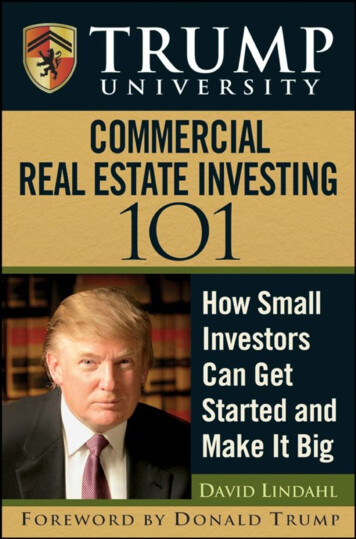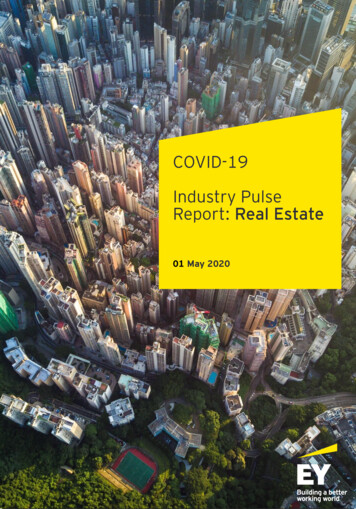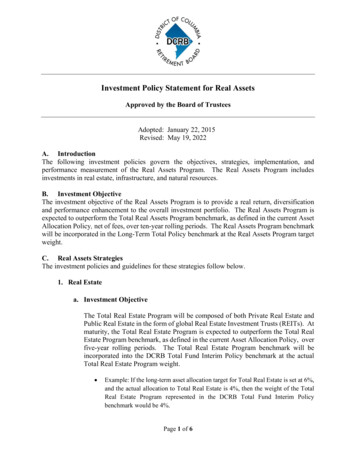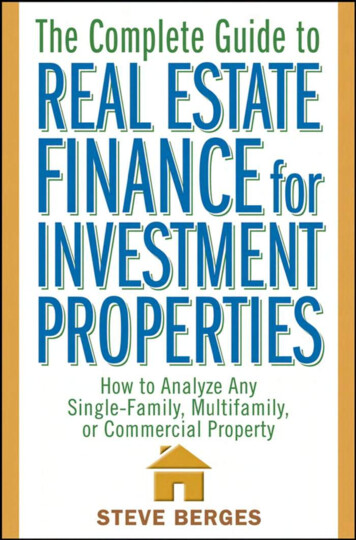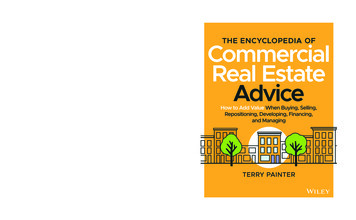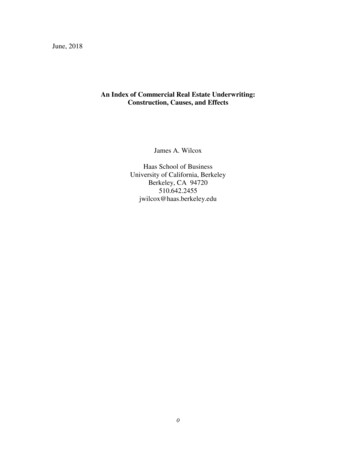
Transcription
June, 2018An Index of Commercial Real Estate Underwriting:Construction, Causes, and EffectsJames A. WilcoxHaas School of BusinessUniversity of California, BerkeleyBerkeley, CA 94720510.642.2455jwilcox@haas.berkeley.edu0
An Index of Commercial Real Estate Underwriting:Construction, Causes, and EffectsAbstractWe constructed an index of the national level of underwriting standards for commercial mortgages. The index incorporates the shifting standards and the shifting marketshares of banks, life insurers, and commercial mortgage-backed securities.Vector autoregressions implied that underwriting importantly affected both commercial real estate mortgage flows and prices. VARs also implied that faster growth ofCRE prices led to easier underwriting, and thus amplifying CRE movements.While prior prices affected underwriting throughout the estimation period, onlyafter the crisis did underwriting respond significantly to predictions about future commercial real estate prices, consistent with the crisis fundamentally changing CRE marketanalysis.1
IntroductionUnderwriting standards for commercial real estate mortgages are now widely regarded ashaving been unusually lax in the years leading up to the financial crisis and the GreatRecession, both of which began in latter 2007. Standards are also widely regarded ashaving tightened sharply during and immediately after that crisis and recession, and thenhaving eased nearly as rapidly and as much in the years that followed.To measure how lax (or stringent) underwriting standards were, and when, weconstructed a quarterly index of the level of underwriting standards for commercialmortgage approvals for 1990-2011. To reflect differing standards and shifting marketshares, the index combined data for underwriting and data for mortgage volumes for thethree largest groups of originators and holders of commercial mortgages: depositories,life insurers, and issuers of commercial-mortgage-backed securities. From each of thethree largest groups, we used two indicators of commercial-mortgage underwriting, aswell as each group’s mortgage volume.The index shows that underwriting standards in the aggregate did ease in the yearsleading up to the financial crisis, but then tightened rapidly and severely. The indexshows that underwriting eased until the financial crisis and then tightened sharply,peaking in 2009, when national financial and economic markets had been weak for sometime and still were weak. In the years following the crisis and the Great Recession,underwriting standards then eased nearly as rapidly and as much as they tightened a few2
years earlier. Even by the end of 2011, however, commercial real estate underwritinghad not become as lax as it had been just before the crisis and recession.In addition to constructing an index that incorporated standards for nonbank as well asbank lenders, we analyzed whether commonly-cited data sufficiently well reflectedaggregate commercial mortgage underwriting after the 1980s. One reason that no singleindicator was likely to be a “sufficient statistic” is, for example, that underwritingstandards may well have loosened before the crisis by more than reflected by commonlycited indicators. Another reason is that, as we show below, the market shares of the threelargest originators and holders of commercial mortgages shifted considerably since the1980s.Perhaps best known as an indicator of commercial-mortgage underwriting is the netpercentage of banks that reported tightening their standards for approving commercialmortgages to the Federal Reserve (Fed). A similar, but much less well known, is the netpercentage of banks that the U.S. Office of the Comptroller of the Currency’s (OCC)bank examiners reported had tightened their underwriting standards for commercial realestate mortgages. Cumulating the net tightening percentages reported by OCC examinersthrough time, for example, implies that banks loosened twice as much during the 1990s(in 1994-1999) as they loosened during the 2000s (in 2004-2007). One reason for thatdisparity was likely that underwriting was especially tight in the wake of the commercialreal estate debacle in the first few years of the 1990s. By comparison, the index impliedthat underwriting standards were a bit easier than average in the early 2000s, and then3
eased from there, by the mid-2000s reducing the index of underwriting tightness to itslowest recorded levels.Relying solely on surveys of banks may be problematic. Although banks remain thelargest single source of commercial mortgage funds, nonbank investors became large andgrowing funders of commercial mortgages. As a result, over our sample period,depositories’ share of all commercial-real-estate-mortgage balances outstanding fell byabout 10 percentage points. To the extent that underwriting by the increasinglyimportant, nonbank investors was generally looser and also loosened more than that ofbanks during the 2000s, survey data for banks from the Fed and OCC were likely to mismeasure the overall level of tightness, and of tightening, of market-wide underwritingstandards for commercial mortgages.In contrast to the survey data, our constructed index implies that underwriting was fartighter during the early 1990s than during the early 2000s. The index also implies thatunderwriting was far looser during the middle of the 2000s and far tighter during andafter the financial crisis than at any time from 1990 through 2011.We used a vector autoregression to estimate how CRE prices and commercial mortgagesresponded to changes in underwriting, and, in turn, how prices and mortgages affectedunderwriting itself. We found that underwriting had important, independent effects on theCRE market. And, in turn, we found that underwriting tended to respond to the CREmarket. In particular, before the crisis, underwriting loosened when CRE had risen morein the recent past. An implication of that finding is that underwriting amplified4
movements in CRE markets: Faster growth of CRE prices led lenders to loosenunderwriting, which raised CRE lending and prices further, which loosened underwritingeven further.We began this study with our hypothesis that, when they reasonably predicted thatmortgage collateral would be worth more in the future, lenders would loosen their currentunderwriting standards. For the period before the crisis, we found little support for thathypothesis: Although past prices helped explain underwriting, predictions of future pricesdidn’t. On the other hand, once we included the crisis years in our sample, the picturebecame more complex: While past prices continue to be directly correlated withunderwriting, predictions of future prices of CRE also significantly explainedunderwriting. Taken together, these results fit with the perspective that the crisis changedhow commercial mortgages were underwritten.The remainder of this paper proceeds as follows. Section II reviews studies of theconnections of underwriting to commercial real estate. Section III provides a theoreticalmodel of the commercial mortgage market. Section IV explains how we combinedinformation from the three largest segments of the commercial mortgage market(depositories, life insurers, and CMBS issuers) to construct our index of commercialmortgage underwriting. Using a vector autoregression, Section V analyzes thereverberation of CRE price growth, underwriting, and mortgage flows on one another.Section VI demonstrates how predictable the future growth of CRE prices is. It thenshows that our measure of those predictions had no detectable effects on underwriting5
before the crisis. Once the crisis years were included in our sample period, however,those predictions had significant effects on underwriting: For instance, predictions oflower future prices would be associated with tighter underwriting. Section VIIsummarizes our evidence and draws some implications.Research on CRE UnderwritingThe financial crisis that began in 2007 produced a torrent of real-estate-related problemsand programs. The crisis has also spawned several studies about how much underwritingof commercial mortgages changed, and why, in the run-up to the crisis. The mixedsignals during the 2000s of whether underwriting eased then produced mixed evaluationssince then. Most, but not all, of the literature points toward underwriting’s having easeduntil the financial crisis erupted, after which it tightened abruptly and severely.Measuring UnderwritingJacob and Manzi (2005) published one of the first articles that claimed that underwritingstandards had eased substantially during the 2000s. They compared typical terms,conditions, and criteria for mortgages that were in CMBS pools that were originated in2004 with those in 1998. The first sentence from their article suggests it was widelyperceived that standards had declined: “Commercial mortgage-backed securities investorsand rating agencies have been wrestling with whether the market has moved too far inrelaxing many of the credit-enhancing features common in the early MBS deals.” Fromtheir vantage point, the relevant question was not whether standards eased, but whetherthey had eased too much: The subtitle of the article was “Have they declined too far?”6
Jacob and Manzi (2005) claimed that for a typical CMBS deal, while both the LTV anddebt-service-coverage ratios (DSCRs) remained unchanged from 1998 to 2004, manyother components of underwriting had apparently loosened. Thus, for the typical deal, by2004, there were more interest-only mortgages, fewer loans (reducing diversification),more 5-year balloon mortgages, more secondary debt, and lower reserves. Particularlystriking, in light of the apparently unchanged reported LTVs, was the increase inMoody’s Stressed LTV from a range of 83-89% to 93-95%. 1 Thus, Jacob and Manzi(2005) implied that the two most commonly-relied-upon indicators of underwritingstandards and default risk, LTVs and DSCRs, were likely to be flawed.Not all observers, however, have concluded that underwriting standards for commercialmortgages eased during the 2000s. Among the most prominent of the naysayers areStanton and Wallace (2018). They make a convincing empirical case that theunderwriting criteria, and in particular the subordination levels, that were required byratings agencies for CMBS tranches to be rated AAA declined considerably before thefinancial crisis struck. Such a decline might well have raised the (dollar-weightedaverage) rating of a given CMBS pool. As a consequence, to the apparently-very-largeextent that investors relied on ratings, the average spread of CMBS yields over Treasurys,for example, would be expected to fall. As suggested by Jacob and Manzi (2005), thatdecline in spreads would, in turn, be expected, at least eventually as supplies and1Moody’s Stressed LTV makes adjustments for how “sustainable” cash flows are. Perhaps more importantly, Stressed LTV uses a consistent set of cap rates, so that changes in assumptions about cap ratesdon’t affect V and thus LTV. We address the connection of cap rates to LTVs in more detail below. Wealso discuss why LTVs are unlikely to be satisfactory indicators of underwriting standards.7
demands equilibrated, to also lead conduit lenders (and then other originators) to reducetheir underwriting criteria. Interestingly, Stanton and Wallace (2018) concluded thatunderwriting did not detectably ease before the crisis on the commercial mortgages thatwent into their CMBS pools.One reason for the divergent views about whether and how underwriting eased during the2000s is that some indicators signaled ease, while others did not. Those who are skepticalabout easing sometimes point to the data on LTVs. One way that underwriting ease mightoccur is by lenders’ raising their ceilings on maximum allowable LTVs (Cohen andManuszak (2013)). Figure 1 shows that the average (first-lien) LTV on commercialmortgages originated by life insurers has generally trended down over the past twodecades. The decline in the LTV series was particularly acute from 2005 through 2008.On the face of it, that suggests that, rather than having levered up, borrowers werefinancing less of their CRE purchases with debt and more with equity. The contrast of theLTV data with anecdotal information and data for other components of underwriting is sostriking that it calls into question whether the LTV data should be taken as reliablysignaling persistent tightening of underwriting over the past two decades in general andduring the real estate bubble in the middle of the 2000s in particular.In residential markets, the surge in piggyback and any other second mortgages that wereoriginated at the time of home purchases during the middle of the 2000s also complicatethe interpretation of the 2000s’ decline of LTVs that were based solely on first8
mortgages. Adding these seconds to firsts, for example, apparently turns the decline intoan increase for residential LTVs (Wilcox (2009)).Interpreting LTVs for commercial mortgages is typically even more difficult than it is forresidential mortgages. The difficulties do not arise primarily from second mortgages,although mezzanine financing might have played a rising role during the 2000s that wasanalogous to residential second mortgages.More importantly, difficulties in interpreting LTVs arise from the practices used togenerate magnitudes of V, the “value” of CRE, that are used to calculate LTVs. Fabozzi(2007) observes that CMBS markets, for example, look to two key indicators of defaultrisk: debt service coverage ratios and LTVs. Presumably banks, life insurance companies,and other originators and investors look to the same two indicators. In practice, accordingto Fabozzi (2007), V tends to be calculated as the ratio of net operating income to a caprate, both of which are subject to considerable discretion on the part of originators.“Thus, analysts are skeptical about estimates of market value and the resulting LTVsreported for properties.”In addition, LTVs are likely to be set in conjunction with lenders’ assessments ofunderlying risks of the CRE that serves as collateral and with the other terms andconditions of commercial mortgages. Grovenstein et al. (2005) make a compelling casefor this endogeneity of LTVs. They point out that potential commercial mortgageborrowers and lenders often bargain over underwriting terms, conditions, and criteria,including LTV. For example, lenders may reasonably trade-off higher LTVs for other,9
tighter terms and conditions. Grovenstein et al. (2005) argue that the resultingendogeneity of LTVs helps explain the otherwise-puzzling empirical findings of no or ofnegative effects of LTV on the (default) performance of commercial mortgages. As aresult, Grovenstein et al. (2005) conclude that, before the financial crisis, LTVs areunreliable indicators of default risk. In contrast, they conclude that an empirically morereliable indicator of default risk is the (also, presumably endogenous) spread of yields oncommercial mortgages over the yields on comparable Treasurys.Reasons Underwriting ChangedJacob and Manzi (2005) hypothesize that eased standards resulted from investors’ being“complacent” about risk, “ no doubt ” due to “ a significant drop in defaults ”They also contend that the eased standards that stemmed from the environment andreduced defaults allowed conduit lenders to either reduce interest rate spreads or weakensome mortgage terms and conditions.Several studies have focused on explanations for why the cap rate, an importantcomponent of underwriting, changed over time, typically tightening in the 1990s andeasing in the 2000s. Chervachidze et al. (2009) address that particular aspect of reducedunderwriting standards during the 2000s: “ the great cap-rate compression ” (italicsadded). They conclude that cap rates typically reflect interest rate and othermacroeconomic conditions. In addition, they find a separate role for the flow of aggregate(not just CRE-related) debt, which surged during the 2000s and thus played a particularlyimportant role then, if not before. These additional effects help add to the model’s ability10
to account for patterns in cap rates. Nonetheless, even their expanded specificationssuggest that cap rates were inexplicably high following the CRE troubles of the early1990s and inexplicably low during the 2000s, especially just before the crisis struck.Ultimately, they attribute these deviations from their estimates by unusually pessimisticand then unusually optimistic sentiments.Clayton, Ling, and Naranjo (2009) concluded that, in addition to being primarilydetermined by fundamentals of the sort that other studies had suggested, cap rates alsoresponded significantly during the 2000s to a “non-fundamental” factor, sentiment.Mei and Saunders (1997) report that past increases of CRE prices raised individualbanks’ CRE lending. One explanation that they consider for their finding is that strongerdemand boosts CRE prices and also boosts the demand for mortgages to fund the higherpriced CRE. They also offer another possibility: When they observe that other banks aremaking more commercial mortgages, banks might decide to join the herd, therebygenerating the correlation that they report. And, yet another explanation might be thatmomentum in CRE prices leads lenders to supply more and/or investors to demand moreCRE mortgages.Reverberating Effects of Changes in UnderwritingJacob and Manzi (2005) suggested that easier standards for CMBS and the ratings of theirtranches reverberated into eased underwriting standards at conduit lenders. Banks and lifeinsurance companies were likely to balance the risks of the large amounts of CMBS that11
they held with the risks of the whole mortgages they had originated and held. If so, theneased underwriting for CMBS and their mortgages may well have led commercial banksand life insurance companies to ease their standards for the commercial mortgages thatthey expected to hold in their portfolios. Thus, competition and portfolio considerationswould likely convey eased underwriting rather broadly across the commercial mortgagemarket.Clayton (2009) explains how a positive feedback loop might develop in CRE markets. Aninitial increase in demand for CRE that makes the market more liquid can thereby fuelhigher CRE prices. As price increases spread across CRE markets, their resulting lowercap rates may spill over into a more general decline in cap rates. When the lower caprates are then used to justify granting larger mortgages, that increase in mortgage supplycan reinforce the original increase in demand for CRE, in liquidity, and in prices. Clayton(2009) uses those mechanisms to account for developments in CRE markets in the yearsleading up to the financial crisis: He shows how “ rose-colored glasses in property proforma projections ” can get translated into “ weak underwriting ” and “ easyaccess to low cost debt ” The resulting increase in the supply of commercial mortgagesthen can fuel mortgage and thus property demand.Arsenault et al. (2012) provide econometric evidence to support the positive feedbackfrom CRE prices to commercial mortgage supply. Based on data for 1991-2011, theyshow that, based on their particular specifications of the variables, faster growth andlower volatility of CRE prices increased the supply of commercial mortgages. In turn,12
they also found that, based on their measure of its exogenous increases, mortgage supplyfurther raised CRE prices. Thus, the CRE market apparently had financing feedbacks thatwere similar to those that allegedly then contributed to downward spirals in other parts ofthe economy during the financial crisis.In part because of data limitations, there are fewer studies that directly connectunderwriting to CRE lending volumes and prices, for either the crisis period or for theyears just before the crisis. Long before the crisis, Hancock and Wilcox (1994, 1997)argued that banks’ capital shortfalls reduced their lending generally and lending forcommercial real estate in particular. Peek and Rosengren (2000) present empiricalevidence that convincingly-exogenous, prior loan losses in Japan reduced Japanesebanks’ capital, which in turn reduced their lending in the U.S. Of course, one mightregard blanket denials of credit to creditworthy borrowers as underwriting beinginfinitely tight. And, it may be that the banks in their studies reduced their lending bydifferentially tightening their underwriting. But, neither Hancock and Wilcox (1994,1997) nor Peek and Rosengren (2000) provided evidence that underwriting was tightenedespecially at capital-constrained banks.The Federal Reserve has long surveyed commercial banks about their underwritingstandards. Unfortunately, the publicly-available survey data does not systematicallyindicate how much banks’ underwriting tightened or loosened. But, Federal Reservesurveys seem consistent with anecdotal reports that banks’ tightened their underwritingparticularly in the early 1990s and during the financial crisis.13
And, some studies have found that the replies to the survey are informative. Based onvector autoregressions, Lown and Morgan (2006) concluded that tighter bank lendingstandards for business loans were correlated with subsequently lower bank lending andreal gross domestic product (GDP). By that yardstick, lending standards outperformedsome alternative indicators of credit conditions, such as business loan interest rates. Theparticular channel that they emphasized was that the reduction in loan supply that wasassociated with tighter lending standards reduced business inventory investment. Lownand Morgan (2006) neither used the banks’ replies about their CRE underwritingstandards nor analyzed whether the CRE market in particular was affected by lendingstandards for commercial loans or for commercial mortgages. O’Keefe, Olin, andRichardson (2003) argued that surveys of bank examiners were informative about banks’underwriting standards in that the surveys helped explain subsequent loan losses.Thus, prior studies have made strong cases that some aspects of underwriting ofcommercial mortgages have tightened and loosened importantly over the 1990s and2000s. Below we take into account several aspects of underwriting and the relativeimportance over time of different sources of mortgage funds. We endeavor to constructan index of the overall stance of commercial mortgage underwriting. We then use vectorautoregressions to estimate the causes and effects of underwriting and of commercial realestate prices and mortgages, both for a sample period that ends before the financial crisisand for one that includes the financial crisis.14
A Model of the Market for Commercial MortgagesHere we present a model of the market, or aggregate, demand for and supply ofcommercial mortgages. The model incorporates a role for underwriting in the demand forcommercial mortgages by borrowers (e.g., builders and investors), as well as in lenders’supply of commercial mortgages. The model’s implied equilibrium relations betweencommercial mortgages, prices, underwriting, and exogenous variables helps motivate theeconometric specifications that we estimate in sections V and VI below. Those relationsalso inform our interpretations of the estimates.We presume that there is enough heterogeneity across lenders, borrowers, andcommercial real estate projects that the model’s elasticities are finite. Heterogeneity isone reason, for example, that everyone in the model is not always at the margin, whichotherwise might lead to some supplies and demands being infinitely elastic at the marketequilibrium. If all projects were identical, then higher borrowing rates might have noeffect on mortgage volume or property prices until, suddenly, when a tiny increase inrates tipped all projects into having negative NPVs, volume went to zero. Instead, here,when Treasury bond yields and contract mortgage interest rates rise by equal amounts,borrowing declines, but is not completely extinguished. Fewer (construction orpurchasing of) projects would be undertaken and some might be scaled down, but some,albeit reduced, amount of lending and borrowing continues in that case.To avoid unnecessary distractions and complications, the model abstracts from long-runeconomic growth and taxes. There is little doubt that such factors can be very important15
in practice, but they are not central to the task at hand. We also assume that each of thevariables corresponds to the economically-relevant horizon. As a result, we couldconsider, for example, the interest rates, expectations about future net operating income(“rents”) and about future commercial real estate prices that pertain to a 10-year horizon.Mortgage SupplyThe aggregate supply of commercial mortgages (M s) depends on the risks to lenders inCRE markets (risk), on a composite measure of all of the underwriting terms, conditions,and criteria that are used by lenders (u), and on other, exogenous shifts in mortgagesupply (M sx):M s s(risk, u, M sx)(1)RiskTo begin, we consider the risks that arise from factors that are external to lenders but thatimportantly affect them. Because they can suffer such large losses when risks turn outadversely, lenders do, of course, deliberately alter their underwriting so as to determinethe resulting (“net” or “internal” to the lender) risks that they bear. We discuss thedeterminants of underwriting in more detail in the next subsection.16
Risk can vary considerably over time. We consider risks to CRE lenders (and borrowers)to be driven by three factors. 2 These three factors tend to be determined predominantlyby overall conditions in the macroeconomy and in the CRE sector. On the other hand, weassume that lenders’ current supply of commercial mortgages has negligible effects onrisk and on the macroeconomy.The first factor that affects risk is the expected future price of commercial real estate. Weposit that higher (expected) prices for commercial real estate reduce current estimates ofrisk: The more valuable that lenders expect the real estate that collateralizes theircommercial mortgages to be in the future, the lower the risks of default and loss thatlenders associate with commercial mortgages.This effect is connected to the mean, or first moment, of expectations about future pricesof commercial real estate. A separate, additional risk arises from the uncertainty, orforecast error variance, that accompanies a forecast of future CRE values. That variance,or volatility, reflects the second moment of the distribution of CRE values. We do notseparately incorporate or measure this latter source of risk. Our empirical implementationincludes a variable that might well capture both expectations and uncertainties, i.e., theforces that are related to first and second moments, of rents. As such, that same variablemay well provide information about expectations and uncertainties of future CRE values.2For simplicity, we take the function that relates the three components to risk to be the same for borrowersand lenders. The effects of risk on supply and demand, however, may differ. That is, Ms is not the same asMd.17
The second factor that affects the risk of commercial mortgages is related to theuncertainty about future net operating income. Borrowers’ currently failing to makepromised mortgage payments may raise lenders’ concerns about future payments andabout CRE market conditions more generally. Thus, we posit that uncertainty aboutfuture rents and occupancy rates is higher when lenders experience higher commercialmortgage delinquency rates (del).We also include a third factor, rx, to capture any sources of risk other than those that areattributable to the first two factors. Thus, we can express the effects of these three factorson risk as:risk r(p, del, rx)(2)UnderwritingWe next discuss the composition of underwriting. Later, we discuss how ourunderwriting index is endogenously determined.Underwriting is typically comprised of several terms, conditions, and criteria, as wediscuss in Section IV. We do not observe the overall, or composite, measure ofunderwriting directly. We can delineate three distinct, but typically complementary,components of lenders’ underwriting. The data from surveys of lenders aboutunderwriting of business loans show that when lenders tighten or loosen theirunderwriting overall, they tend to do so by adjusting many of their underwriting terms,conditions, and criteria in the same direction.18
The first component of underwriting is the spread (s) of the mortgage interest rate over arelevant benchmark rate. Lenders typically raise the spread to control their expectedreturns in light of their risks and to take advantage of any market power that they mighthave. Note that the benchmark interest rate itself does not directly enter equation 1. (Thebenchmark interest rate will quite directly affect the demand for commercial mortgagesbelow.)One candidate for the benchmark rate is the yield on 10-year Treasurys. To the extent thatthe rates on alternative investments or on funding costs are connected more to shortermaturity yields, the yield spread (s) might be set relative to those shorter-maturity yields.Commercial banks, for example, might rely heavily on yields that move closely with thefederal funds interest rate. Life insurers, on the other hand, may regard 10-year Treasuryyields as their relevant benchmark rate. Either way, it is a spread, rather than abenchmark rate, that is more directly relevant to lenders.In addition to this “price” component of underwriting, we include two “non-price”components that are suggested by the discussion of lending practices that we present inSection IV. The second component is based on the mortgage balance (M) relative to thevalue (V) of the property being financed. (For ease of exposition, rather than M/V, theloan-to-value (LTV
Underwriting standards for commercial real estate mortgages are now widely regarded as having been unusually lax in the years leading up to the financial crisis and the Great Recession, both of which began in latter 2007. Standards are also widely regarded as having tightened sharply during and immediately after that crisis and recession, and then
